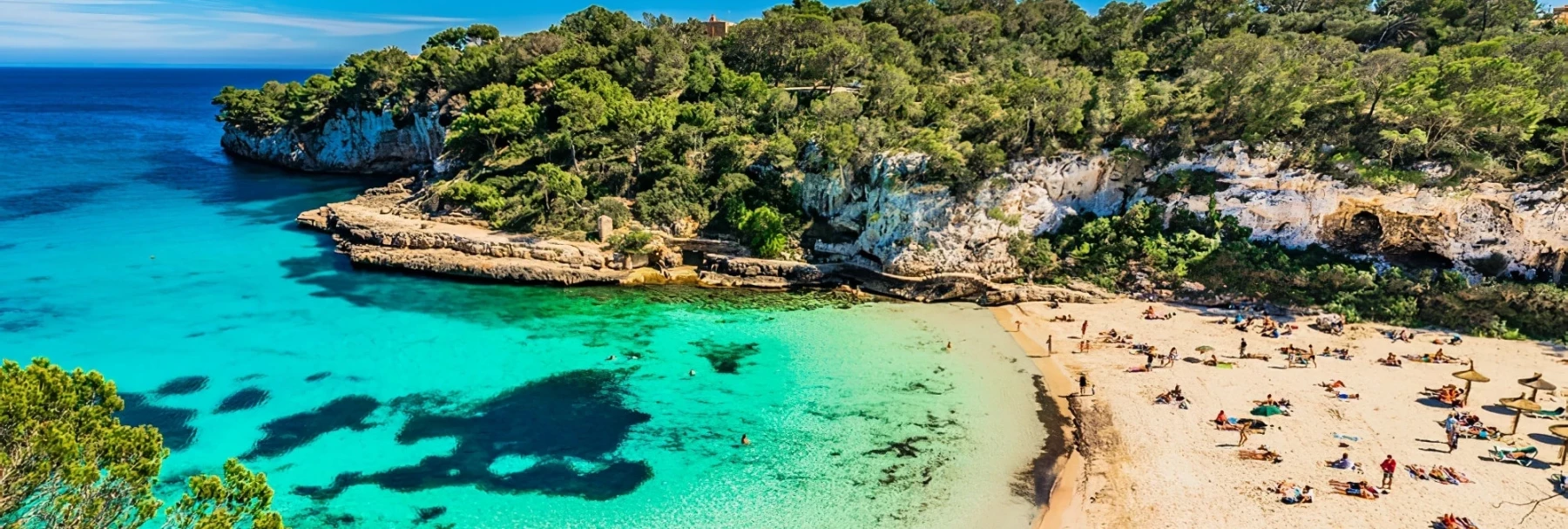The 12 essential things to do on the Island of Mallorca
Last update : 26/05/2024 15:43Summary
- To visit
-
- 1 - Palma de Mallorca
- 2 - Playa de Palma
- 3 - Cala Millor
- 4 - Es Trenc
- 5 - Cala d'Or
- 6 - Valldemossa
- 7 - Sóller
- 8 - Deià
- 9 - Hike the Serra de Tramuntana
- 10 - Cuevas del Drach
- 11 - Cap de Formentor
- 12 - Événements et Festivals
- Majorca - Where to Stay?
- Majorca - How to get around?
- Majorca - Best period
Majorca, also known as Mallorca in Spanish and Catalan, is the largest of the Balearic Islands, an archipelago of Spain located in the Mediterranean Sea. The island is renowned for its stunning beaches, picturesque landscapes, and rich cultural and historical heritage. The capital city is Palma, a vibrant city with impressive architecture, including the famous La Seu Cathedral.
Majorca enjoys a Mediterranean climate with hot, dry summers and mild winters. The best time to visit depends on your preferences: summer for beaches and nightlife, spring and autumn for outdoor activities and cultural visits without the summer crowds.
In summary, Majorca is a diverse destination that offers something for every type of traveler, whether it’s relaxation, adventure, culture, or gastronomy.
1 - Palma de Mallorca
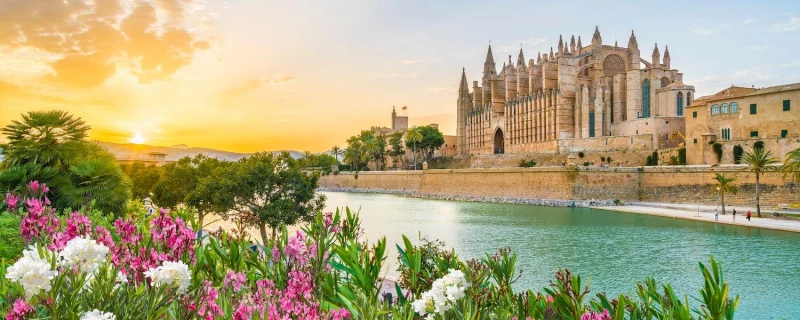
Palma de Mallorca, the enchanting capital of the island of Mallorca in the Balearic archipelago, is a captivating destination for travel enthusiasts. With its winding cobblestone streets, historic buildings with golden stone facades, and majestic palm trees lining the waterfront, Palma offers a perfect blend of Mediterranean charm and rich history.
Travelers can wander through the labyrinthine streets of the old town, discovering architectural treasures such as the stunning Gothic cathedral of Palma, the famous La Seu, proudly overlooking the sea. Local markets brim with fresh produce and culinary specialties, inviting visitors to taste authentic island flavors.
The beaches along Palma Bay are an invitation to relaxation and water sports. Whether sunbathing on golden sands or exploring hidden coves by kayak, there's something for everyone. In the evenings, lively restaurants and bars offer delicious cuisine and refreshing cocktails, while illuminated alleyways pulse with music and dance.
For history and culture enthusiasts, Palma also boasts fascinating museums, contemporary art galleries, and vibrant festivals throughout the year. Exploring the city reveals a new facet of its cultural heritage and warm atmosphere around every corner.
 Our tips for getting the most out of your experience.
Our tips for getting the most out of your experience.
To make the most of your visit to Palma de Mallorca, here are some helpful tips:
-
Explore the Old Town on Foot: Palma's old town is a maze of picturesque alleys, charming squares, and historic buildings. Wander around on foot to discover hidden gems such as La Seu Cathedral, the Almudaina Palace, and the Arab Baths.
-
Visit Palma Cathedral (La Seu): This stunning Gothic cathedral is a symbol of Palma. Make sure to visit the interior to admire its impressive vaults and spectacular stained glass windows. Sunrise offers beautiful light through the windows.
-
Enjoy Local Markets: Markets like Mercat de l'Olivar provide an authentic experience where you can taste fresh local produce, tapas, and island specialties. It's also a great place to buy handmade souvenirs.
-
Explore Art and Culture: Palma is home to several interesting museums such as Es Baluard Museum of Modern and Contemporary Art and the Museum of Mallorca, showcasing diverse collections from modern art to archaeology.
-
Discover Beaches and Surroundings: Don't miss out on the beautiful beaches around Palma, such as Playa de Palma and Cala Major. You can also rent a car to explore the scenic coastline or the picturesque inland areas of the island.
-
Stroll along Passeig Marítim: This seaside promenade offers stunning views of Palma Bay and is perfect for a relaxing walk or enjoying an outdoor meal with a sea view.
-
Taste Local Cuisine: Palma's restaurants and bars offer delicious Mediterranean cuisine, fresh seafood, and local specialties like sobrassada (Majorcan sausage) and ensaïmades (spiral pastries).
-
Attend Local Festivals and Events: Throughout the year, Palma hosts various festivals such as the Sant Sebastià festivities in January and the festes de la Mare de Déu de la Salut in September, providing an immersion into local culture.
By following these tips, you can fully enjoy everything Palma de Mallorca has to offer, exploring its cultural treasures, savoring its delicious cuisine, and taking in its enchanting landscapes.
2 - Playa de Palma
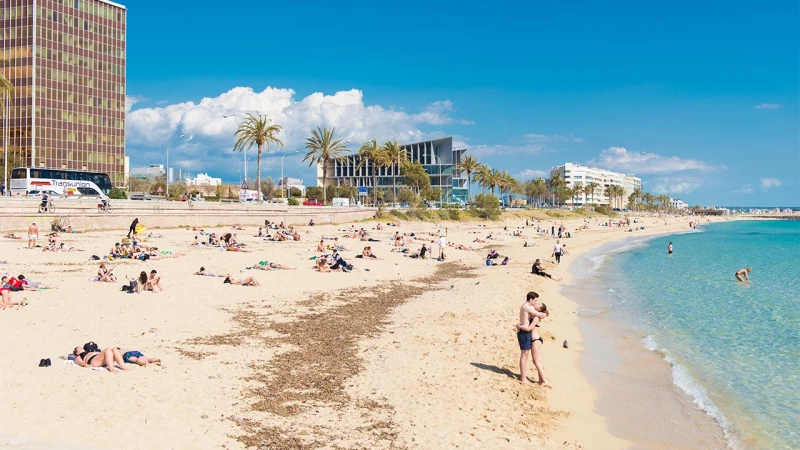
Playa de Palma is a beautiful beach resort located on the Spanish island of Mallorca in the Mediterranean Sea. Known for its stunning sandy beaches, crystal-clear waters, and vibrant nightlife, Playa de Palma attracts visitors from all over the world seeking relaxation and entertainment.
During the day, visitors can soak up the sun on the beach, take part in water sports like jet skiing and windsurfing, or explore the nearby shops and restaurants. In the evenings, the area comes alive with bars, clubs, and discos offering a lively atmosphere and a chance to dance the night away.
The promenade along Playa de Palma is lined with palm trees and offers picturesque views of the sea, making it a popular spot for leisurely strolls or bike rides. Additionally, the resort is close to Palma de Mallorca, the island's capital, where visitors can explore historic sites such as the Cathedral of Santa Maria and the Royal Palace of La Almudaina.
3 - Cala Millor
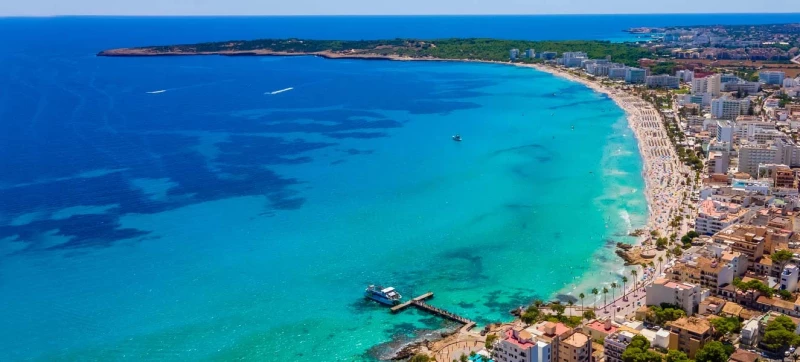
Cala Millor is a popular tourist destination located on the eastern coast of the Spanish island of Mallorca (Majorca), which is part of the Balearic Islands archipelago. Known for its beautiful beaches, crystal-clear waters, and vibrant nightlife, Cala Millor attracts visitors from all over the world, especially during the summer months.
The beach in Cala Millor stretches for over 1.5 kilometers and offers soft golden sand, making it perfect for sunbathing and swimming. Water sports such as snorkeling, scuba diving, and jet skiing are also popular activities in the area.
Aside from its natural beauty, Cala Millor boasts a wide range of restaurants, bars, and shops catering to tourists. Visitors can enjoy delicious Spanish cuisine, fresh seafood, and traditional dishes while taking in the picturesque views of the Mediterranean Sea.
In addition to its beaches and nightlife, Cala Millor is also known for its family-friendly attractions, including mini-golf courses, go-karting tracks, and water parks, making it an ideal destination for travelers of all ages.
4 - Es Trenc
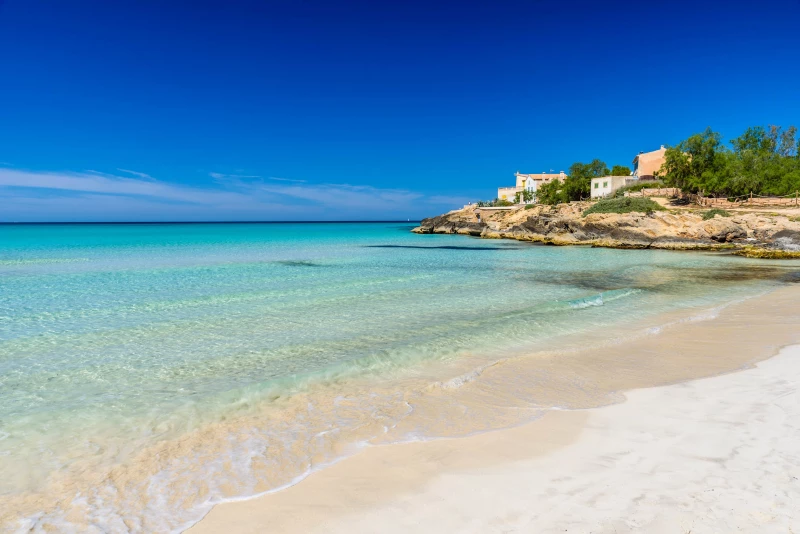
Es Trenc is a stunning beach located on the southern coast of the Spanish island of Mallorca (Majorca). Known for its crystal-clear turquoise waters, fine white sand, and natural surroundings, Es Trenc is often regarded as one of the most beautiful beaches in Mallorca and even in the entire Mediterranean region.
Es Trenc stretches for about 3 kilometers and is relatively undeveloped compared to some other beaches on the island. This gives it a more natural and tranquil atmosphere, attracting visitors looking to escape the crowds and enjoy the pristine beauty of nature.
The beach is backed by sand dunes and pine trees, providing some shade and adding to its picturesque charm. The shallow waters are perfect for swimming, and the beach is also popular for sunbathing, picnicking, and beach sports.
While Es Trenc can get busy during the peak summer months, particularly on weekends, it still retains much of its unspoiled beauty and is definitely worth a visit for anyone traveling to Mallorca.
5 - Cala d'Or
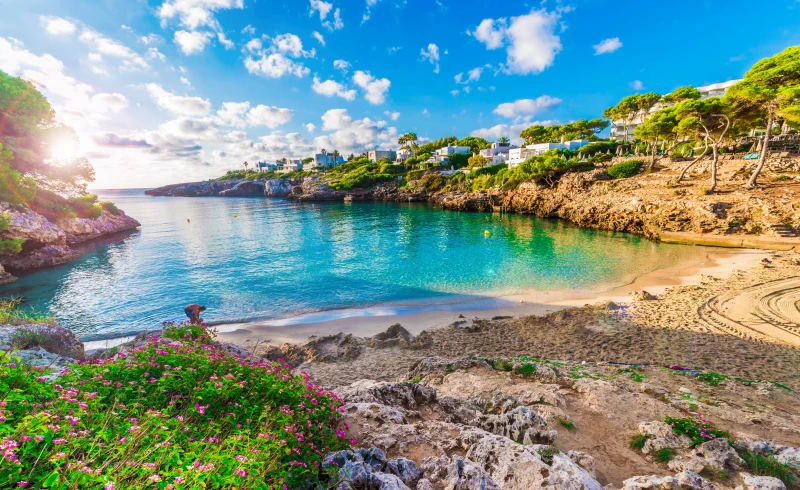
Cala d'Or is a popular resort town located on the east coast of the island of Majorca, Spain. It is renowned for its stunning beaches and crystal-clear waters, drawing numerous visitors each year.
The name "Cala d'Or" translates to "Golden Cove" in Catalan, reflecting the golden coves and sandy beaches found in the area. The resort town is characterized by its traditional white-washed houses, well-maintained gardens, and picturesque small coves.
Cala d'Or boasts several beautiful beaches, each with its own charm. Among the most popular are Cala Gran, Cala Esmeralda, and Cala Ferrera. These beaches are perfect for swimming, snorkeling, and sunbathing.
In addition to beaches, Cala d'Or offers a range of tourist amenities including shops, restaurants, bars, and a vibrant nightlife, making it an appealing destination for vacationers seeking relaxation and entertainment.
Cala d'Or is easily accessible from Palma de Mallorca Airport, located approximately 60 kilometers to the west, and serves as an ideal base for exploring other attractions in Majorca, such as quaint inland villages or secluded coves along the coast.
 Our tips for getting the most out of your experience.
Our tips for getting the most out of your experience.
Here are some tips to make the most of your stay in Cala d'Or:
-
Explore Hidden Coves: While the main beaches are beautiful, venture out to discover smaller, secluded coves along the coast. They often offer tranquility and unparalleled natural beauty.
-
Snorkeling: The clear waters of Cala d'Or make it an ideal spot for snorkeling. Bring your own gear or rent it locally to explore the colorful marine life.
-
Visit Local Markets: Experience the vibrant atmosphere of local markets where you can find crafts, fresh produce, and regional specialties. The weekly market in nearby Santanyí is particularly popular.
-
Sample Local Cuisine: Don't miss out on trying Majorcan dishes at local restaurants. Many offer fresh seafood and delicious regional specialties.
-
Boat Excursions: Take a boat trip to explore the stunning coastal landscapes of Cala d'Or. Discover hidden coves, sea caves, and perhaps even spot dolphins.
-
Stroll through the Town: Wander through the charming town center of Cala d'Or to admire traditional architecture, shop in local boutiques, and soak up the Mediterranean atmosphere.
-
Watch the Sunset: End your day by watching a spectacular sunset from one of Cala d'Or's beaches. It's the perfect time to capture stunning photos and unwind while taking in the view.
By following these tips, you're sure to have an unforgettable time in Cala d'Or!
6 - Valldemossa
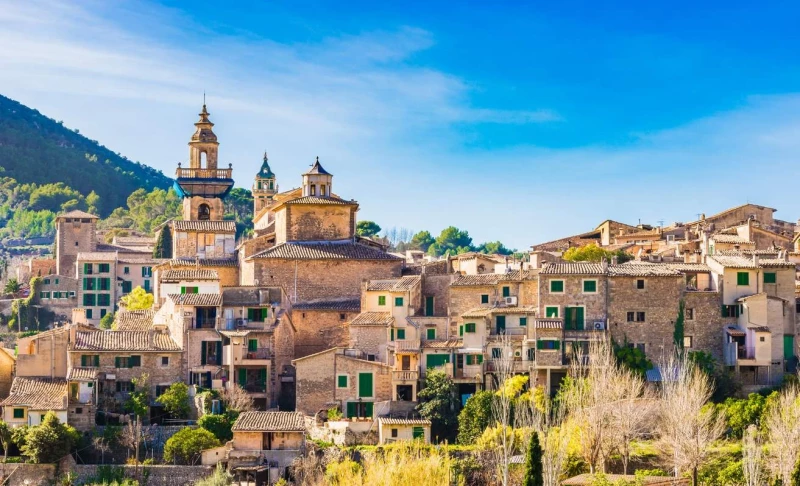
Valldemossa is a picturesque village located in the Serra de Tramuntana mountains on the island of Majorca (Mallorca), which is part of Spain's Balearic Islands. It is known for its charming narrow streets, historic buildings, and stunning views of the surrounding countryside. One of its most famous attractions is the Royal Carthusian Monastery of Valldemossa, where the composer Frédéric Chopin and the writer George Sand spent a winter in 1838-1839. The monastery, along with its beautiful gardens, is a popular tourist destination and a symbol of Valldemossa's rich cultural heritage.
 Our tips for getting the most out of your experience.
Our tips for getting the most out of your experience.
Here are some tips to make the most of your visit to Valldemossa:
-
Visit the Valldemossa Monastery: Explore this historic monastery where Chopin and George Sand stayed. Marvel at the architecture and well-maintained gardens.
-
Stroll through the picturesque alleys: Get lost in the narrow winding streets of the village. It's a great way to soak in the authentic atmosphere of Valldemossa.
-
Taste local specialties: Try local products like ensaïmadas (typical pastries), sobrassadas (sausages), and wines from Majorca at small restaurants and cafes in the village.
-
Enjoy panoramic views: Hike or drive to viewpoints around Valldemossa for spectacular panoramas of the Mediterranean Sea and surrounding mountains.
-
Explore nearby attractions: Discover the surroundings of the UNESCO World Heritage-listed Serra de Tramuntana and visit other picturesque villages like Deià or Sóller.
-
Appreciate art and culture: Valldemossa also hosts art galleries, craft shops, and music concerts that reflect Majorca's rich cultural traditions.
By following these tips, you'll have a memorable experience in Valldemossa, enjoying everything this beautiful village has to offer.
7 - Sóller
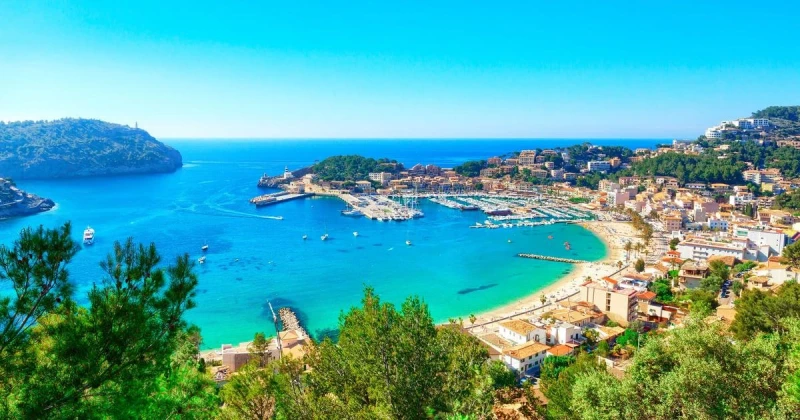
Sóller, nestled in the heart of the picturesque island of Majorca in Spain, is an enchanting destination that captivates travelers with its unique charm. Surrounded by the majestic mountains of the Serra de Tramuntana, this small town offers a perfect blend of spectacular nature and traditional architecture.
The narrow cobblestone streets invite leisurely strolls, revealing buildings with ochre stone facades and flower-adorned balconies. The historic town center bustles with a lively Mediterranean atmosphere, where cafes, local craft shops, and colorful markets delight the senses.
Sóller is also famous for its juicy oranges and fresh orange juice, cultivated in the surrounding orchards that populate the fertile valley. A ride on the iconic Sóller train, dating back to the early 20th century, offers a nostalgic journey through stunning landscapes of mountains and verdant valleys.
Beach enthusiasts will find solace in the nearby charming Port de Sóller, with its golden sandy beaches lined with seafood restaurants and outdoor cafes.
Whether exploring scenic hiking trails, indulging in delicious local cuisine, or simply relaxing while soaking in its breathtaking natural scenery, Sóller promises a memorable getaway where every corner reveals a new facet of its rich heritage and natural beauty.
 Our tips for getting the most out of your experience.
Our tips for getting the most out of your experience.
Here are some tips to make the most of your visit to Sóller:
-
Sóller Train: Don't miss the picturesque journey aboard the historic Sóller train. Make sure to book your tickets in advance, especially during peak season, to avoid queues.
-
Hiking in Serra de Tramuntana: Explore the stunning hiking trails in the Serra de Tramuntana surrounding Sóller. Ensure you have sturdy walking shoes and water, as some trails can be demanding but offer spectacular views.
-
Sóller Market: Visit the local market to discover fresh produce, artisan souvenirs, and the lively atmosphere of daily life in Sóller. The market typically takes place on Saturday mornings.
-
Stroll through the Historic Center: Get lost in the charming cobblestone streets of Sóller and explore local architecture, quaint shops, and welcoming cafes.
-
Trip to Port de Sóller: Take a short walk or ride the vintage tram to the nearby Port de Sóller. Enjoy the beach, seafood restaurants, and panoramic views of the Mediterranean.
-
Taste Local Specialties: Don't leave Sóller without trying its fresh oranges and natural orange juice. Also, sample local cuisine including fresh fish dishes and typical sweets of Majorca.
-
Timing Tips: Avoid crowds by visiting tourist sites early in the morning or later in the day. This allows you to appreciate the peaceful beauty of Sóller even more.
By following these tips, you'll be well-prepared to explore and enjoy everything Sóller has to offer, whether it's its spectacular nature, rich cultural heritage, or local culinary delights.
8 - Deià
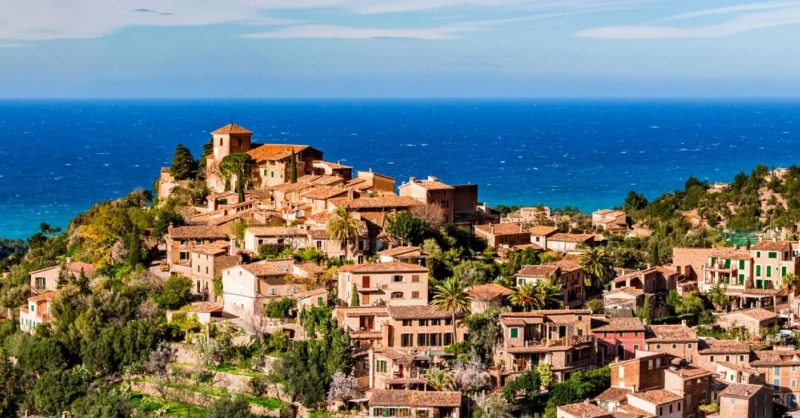
Deià is a hidden gem nestled on the northwest coast of Majorca, a sunny island in the Balearic archipelago of Spain. This picturesque village is renowned for its artistic and bohemian atmosphere, attracting travelers seeking natural beauty and creative inspiration.
Located at the foot of the Serra de Tramuntana, a UNESCO World Heritage site, Deià offers spectacular views of the Mediterranean Sea and the surrounding hills. Narrow cobbled streets are lined with traditional stone houses, lush gardens, and shaded terraces perfect for relaxation.
The village has long been a haven for artists, writers, and musicians drawn to its natural beauty and peaceful ambiance. It is said that Robert Graves, the British poet and writer, helped establish Deià as a renowned artistic destination.
Visitors can explore local art galleries, artisan shops, and charming cafes offering delicious Mediterranean cuisine. Deià also serves as an excellent starting point for hikes through Majorca's wild and preserved nature, or for discovering secluded beaches and hidden coves along the coast.
For those seeking authenticity and tranquility, Deià provides a unique travel experience where time seems suspended between tradition and contemporary creativity, in a preserved and enchanting natural setting.
 Our tips for getting the most out of your experience.
Our tips for getting the most out of your experience.
To make the most of your visit to Deià, here are some useful tips:
-
Choose the right time: Deià is enjoyable year-round, but consider avoiding the hottest months of July and August if you prefer milder temperatures and fewer crowds. Spring (April-May) and fall (September-October) are generally ideal.
-
Getting around: Deià is a small village that is easily explored on foot. Wander through the cobbled streets and discover local shops and art galleries at your own pace.
-
Explore the surroundings: Take advantage of hiking trails in the Serra de Tramuntana. The road from Valldemossa to Deià offers spectacular views and can be accessed by car or bike for the more adventurous.
-
Discover local art and culture: Visit the Casa Museu Robert Graves to learn about the history and culture of the village. Explore local art galleries that often showcase the work of contemporary artists inspired by the beauty of Majorca.
-
Relax at the beach: While Deià itself doesn't have a beach, there are picturesque coves nearby such as Cala Deià where you can swim in crystal-clear waters and enjoy tranquility.
-
Taste local cuisine: Indulge in Mediterranean dishes at local restaurants. Don't miss trying "sobrassada," a typical Majorcan sausage, and fresh seafood.
-
Respect the peaceful ambiance: Deià is cherished for its tranquility and relaxed atmosphere. Respect local residents and the environment by maintaining a considerate and unobtrusive demeanor.
By following these tips, you'll ensure a fulfilling visit to Deià and experience all aspects of this charming Majorcan village.
9 - Hike the Serra de Tramuntana
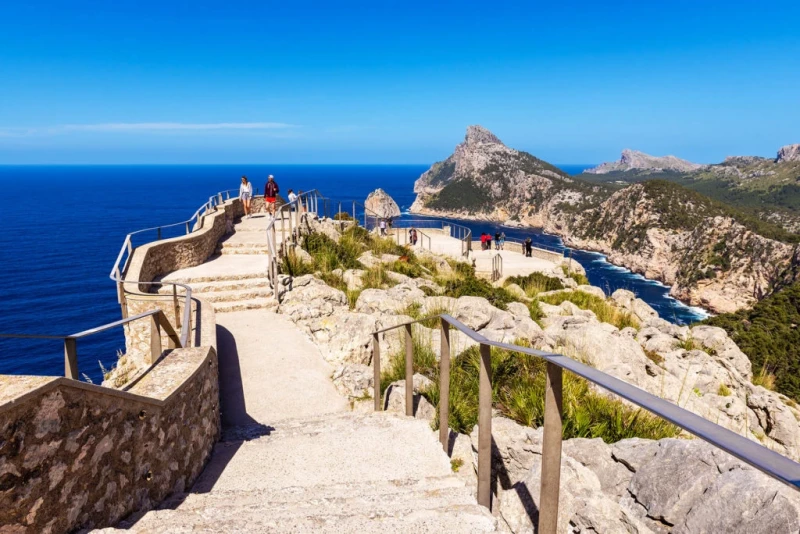
The Serra de Tramuntana is a stunning mountain range located on the island of Majorca, Spain. Hiking through this region offers an unforgettable experience with spectacular views of the Mediterranean Sea and mountain landscapes.
Hiking trails in the Serra de Tramuntana cater to various skill levels, ranging from leisurely walks along ridges to more challenging routes for experienced hikers. You can explore picturesque villages perched atop mountains, impressive cliffs, and dense forests.
It's advisable to hike early in the morning or late in the day to avoid intense heat, especially during the summer months. Ensure you have an adequate supply of water and wear appropriate clothing and comfortable hiking shoes. Also, it's a good idea to carry a map or download routes on your phone as some parts of the Serra de Tramuntana can be quite remote.
Whether you're a nature enthusiast or a hiking aficionado, exploring the Serra de Tramuntana will leave you with unforgettable memories of Majorca's natural beauty.
 Our tips for getting the most out of your experience.
Our tips for getting the most out of your experience.
Here are some tips to make the most of your hiking experience in the Serra de Tramuntana:
-
Preparation: Research different trails, their difficulty levels, and notable points of interest before setting out. Check weather conditions to choose the best time for your hike.
-
Appropriate Gear: Wear comfortable hiking clothes and sturdy, waterproof hiking shoes. Bring a hat, sunglasses, and sunscreen to protect yourself from the sun.
-
Hydration and Nutrition: Carry enough water for the duration of your hike, especially in hot weather. Pack energy snacks like dried fruits, energy bars, or sandwiches to keep you fueled along the way.
-
Navigation: Carry a detailed map of the area or use GPS mapping apps to navigate your route. Some areas may lack signage, so self-navigation is crucial.
-
Respect the Environment: Leave no trace. Pack out all your trash and respect local environmental regulations.
-
Personal Safety: Inform someone of your itinerary and expected return time. Carry a fully charged cell phone and relevant emergency contact information.
-
Enjoy the Experience: Take time to admire the landscapes and soak in the tranquility of nature. Take regular breaks to rest and appreciate the surroundings.
By following these tips, you'll be well-prepared to have a rewarding and safe hiking experience in the beautiful Serra de Tramuntana.
10 - Cuevas del Drach

The Cuevas del Drach (Caves of Drach) are a very famous tourist attraction in Mallorca, Spain. They are located on the east coast of the island, near the town of Porto Cristo. These caves are known for their spectacular formations of stalactites and stalagmites, as well as for an underground lake called Lake Martel, one of the largest underground lakes in the world.
The highlight of the Cuevas del Drach is the light and music show that takes place on Lake Martel. Visitors can enjoy a guided tour of the caves and then witness a classical music concert on boats while sailing across the lake, which is beautifully illuminated.
In addition to their natural beauty, the Cuevas del Drach hold significant historical and geological importance and have been a popular attraction since they were discovered in the late 19th century. It is a highly sought-after destination for tourists visiting Mallorca seeking natural beauty and unique experiences.
 Our tips for getting the most out of your experience.
Our tips for getting the most out of your experience.
Here are some tips for visiting Cuevas del Drach (Dragon Caves) in Mallorca, Spain:
-
Opening Hours: Check the opening hours before planning your visit. The caves are typically open daily, but hours may vary depending on the season.
-
Tickets: It's recommended to buy your tickets in advance, especially during peak tourist season, to avoid long queues.
-
Guided Tour: Visits to the caves are usually guided. Pay attention to your guide's instructions to fully enjoy the experience.
-
Clothing: The caves are cool and humid, so wear comfortable clothes and suitable walking shoes.
-
Photography: Photography is often permitted inside the caves, but be sure to follow any rules and guidelines provided by your guide.
-
Lake Martel: Don't miss the famous boat trip on Lake Martel at the end of the tour, where you can listen to a classical music concert. It's a unique and highly appreciated experience.
-
Accessibility: The caves may involve stairs and uneven paths, which could limit accessibility for people with reduced mobility. Check in advance for any special accommodations available.
-
Environment: Respect the natural environment of the caves by avoiding touching the rock formations and following conservation rules.
By following these tips, you should be able to fully enjoy your visit to Cuevas del Drach and have an unforgettable experience in this fascinating place.
11 - Cap de Formentor
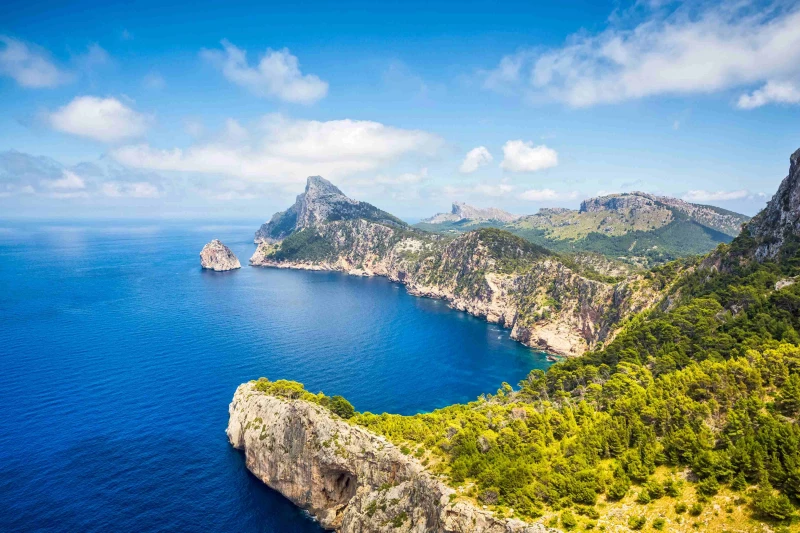
Cap de Formentor is a spectacular peninsula located on the northern tip of the island of Mallorca, Spain. It is renowned for its stunning natural beauty, rugged cliffs, and panoramic views over the Mediterranean Sea. The area is popular among tourists and photographers alike for its dramatic landscapes and the picturesque lighthouse, Faro de Formentor, which sits at the end of the cape.
Visitors often drive or cycle along the winding road that leads to Cap de Formentor, passing through pine forests and rocky coastline. The journey itself is part of the attraction, offering numerous scenic viewpoints along the way. Some notable stops include Mirador Es Colomer, which provides breathtaking vistas of the cliffs and sea below.
Cap de Formentor is also known for its biodiversity, with various bird species inhabiting the area, making it a popular spot for birdwatching. The combination of its natural beauty and ecological significance makes Cap de Formentor a must-visit destination for nature enthusiasts and travelers exploring Mallorca.
12 - Événements et Festivals
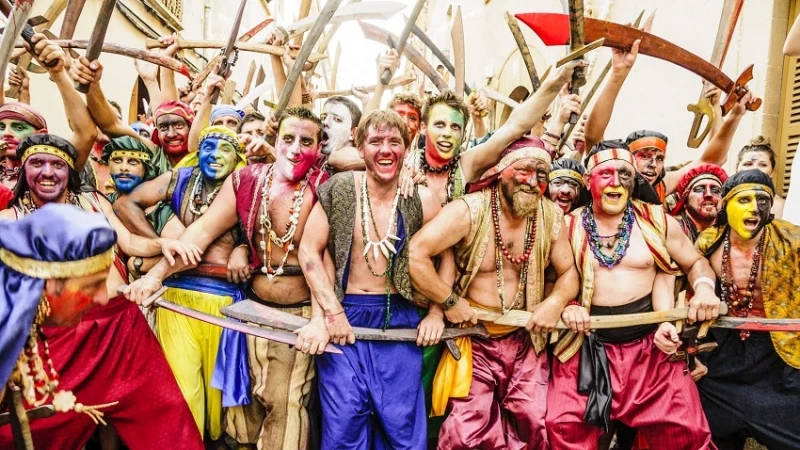
Majorca, the largest island in the Balearic Islands of Spain, hosts numerous events and festivals throughout the year. Here are some of the most popular and interesting events in Majorca:
-
Saint Sebastian Festivities (January): Traditional celebrations including parades, fireworks, and religious events in honor of Saint Sebastian.
-
Saint Anthony's Day (January): Popular festivities with bonfires, parades, and dances to celebrate this patron saint.
-
Carnival of Majorca (February): A colorful carnival featuring parades of floats, elaborate costumes, music, and dancing in major towns across the island.
-
Saint John's Eve (June): Celebrations on the shortest night of the year with bonfires on the beaches, concerts, and community events.
-
Virgen de la Victoria Festival (July): Religious celebrations and festivities honoring Majorca's patron saint, including processions and cultural events.
-
Mare de Déu d'Agost Festivities (August): Popular festivals in many towns of Majorca featuring parades, concerts, traditional dances, and fireworks.
-
Nit de l'Art in Palma (September): A night dedicated to contemporary art with open art galleries, exhibitions, performances, and installations throughout Palma's streets.
-
Harvest Festival (September): Celebration of the grape harvest with wine tastings, grape pressing competitions, and gastronomic events.
-
Jazz Voyeur Festival (November): A jazz festival in Palma featuring live concerts, jam sessions, and events at various venues across the city.
-
Christmas Markets (December): Festive atmosphere with traditional Christmas markets in Palma and other towns on the island, offering local crafts, gastronomy, and entertainment.
These events and festivals showcase Majorca's cultural diversity and historical richness, attracting both locals and visitors throughout the year.
Majorca - Where to Stay?
o visit Majorca, here are some lodging options based on your preferences and budget:
-
Palma de Mallorca: The island's capital offers a variety of accommodations, from luxury hotels to budget-friendly hostels. It's ideal if you want to be in the heart of the action with easy access to cultural attractions, restaurants, and shops.
-
Sóller and Valldemossa: These charming mountain villages provide a picturesque and tranquil atmosphere. You'll find boutique hotels and guesthouses in historic buildings, perfect for those seeking an authentic and relaxing experience.
-
Alcúdia: Located in the north, Alcúdia features a beautiful beach and a medieval old town. It's a great choice if you want to combine beach relaxation with exploring the scenic surroundings.
-
Port de Pollença: This peaceful seaside resort is also situated in the north, offering accommodation options along the waterfront promenade. It's ideal for beach lovers and water sports enthusiasts.
-
Cala d'Or: On the east coast, Cala d'Or is known for its picturesque coves with crystal-clear waters. It's a pleasant place to stay if you're looking for scenic beaches and a laid-back atmosphere.
-
Magaluf and Palma Nova: These two resorts are livelier and popular among young people and families looking for entertainment, nightlife, and activities.
-
Rural Majorca: For a more secluded experience close to nature, consider staying in a finca (traditional Majorcan farmhouse) inland. This is perfect for those wanting to explore rural landscapes and traditional villages.
Depending on your itinerary and preferences, you can choose from these various lodging options in Majorca to make your stay as comfortable and memorable as possible.
Majorca - How to get around?
To visit Majorca, you have several transportation options depending on your preferences and budget:
-
Rental car: This is the most flexible option for exploring the island at your own pace. Rental agencies are available at Palma Airport and in major towns like Palma de Mallorca, Alcúdia, and Sóller.
-
Public transport: Majorca has a good bus network operated by TIB (Transports de les Illes Balears). Buses connect most towns and villages on the island, with frequent services to Palma. It's a budget-friendly option, though less convenient for more remote areas.
-
Bicycles: Majorca is popular for cycling, with numerous well-marked routes and trails. You can rent bikes at various locations around the island and enjoy the scenery while getting some exercise.
-
Taxi: Taxis are available in Palma and tourist areas. They are convenient for shorter trips or if you prefer to avoid driving yourself.
-
Organized tours: If you prefer a guided approach, many agencies offer bus tours to popular sites like the Caves of Drach, Valldemossa, or Cap de Formentor.
Depending on your itinerary and travel style, you can mix and match these options to make the most of your visit to Majorca.
Majorca - Best period
The best time to visit Majorca depends on your preferences for climate and activities:
-
Spring (April to June): This is an ideal time with pleasant temperatures typically ranging from 20°C to 25°C. The landscapes are lush green and flowers are in bloom, perfect for hiking, cycling, and outdoor activities.
-
Summer (July to September): Summers in Majorca are hot, with daytime temperatures often above 30°C. It's the peak tourist season, so beaches and attractions are bustling. Ideal for sun-seekers and water activities enthusiasts.
-
Autumn (October to November): Temperatures remain mild in autumn, around 20°C to 25°C early in the season, cooling slightly toward late November. It's less crowded than summer, offering lower prices and a quieter atmosphere.
-
Winter (December to March): Majorca experiences a mild winter compared to many other regions, with daytime temperatures generally staying above 10°C to 15°C. It's a quiet time on the island, great for hiking, exploring traditional villages, and cultural visits.
In summary, spring and autumn are often considered the best seasons to visit Majorca due to pleasant temperatures and fewer crowds compared to summer. However, if you enjoy intense heat and summer activities, then summer might be the ideal time for you.
